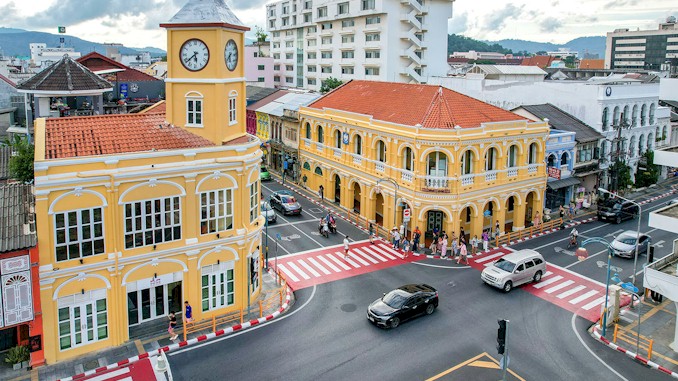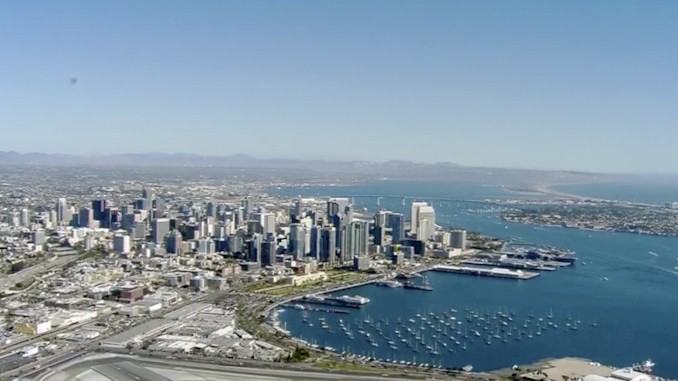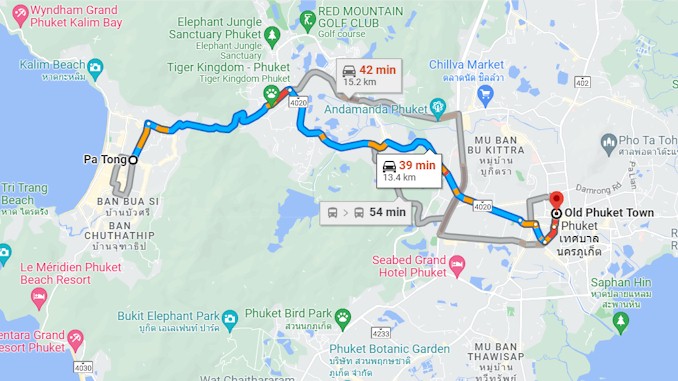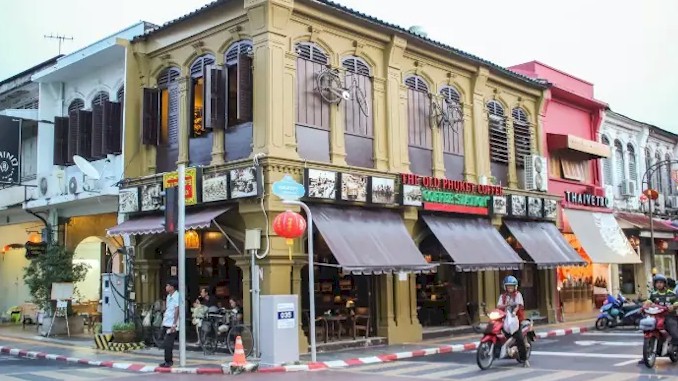Top 10 Best Museums in Old Phuket Town
If you are looking for a cultural and historical experience in Thailand, you might want to visit the Old Phuket Town. This charming area is filled with colorful buildings, street art, temples, and museums that showcase the rich heritage of Phuket. In this blog post, I will share with you the top 10 best museums in Old Phuket Town that you should not miss. Whether you are interested in art, history, or culture, these museums will offer you a glimpse into the past and present of this fascinating island. Read on to find out more!
The top 10 best museums in Old Phuket Town are:
- Thai Hua Museum: A well-designed museum that showcases the history and culture of the Chinese immigrants in Phuket.
- Chinpracha House Museum: A privately owned museum that displays the personal items and furniture of the Chinpracha family, who lived in a Sino-Portuguese mansion.
- Baan Ar Jor House Museum: A private house converted into a hotel and a restaurant, with a collection of photos and objects from the tin mining era.
- Peranakannitat Museum: A museum that tells the story of Phuket from its early history to the present day, with photo exhibitions and workshops.
- Phuket Glass Plates Museum: A museum that features a collection of glass plates with images of Phuket from the late 19th and early 20th centuries.
- Mining Museum: A museum that documents the history of tin mining in Phuket, with wax figures, models, and mock-ups of the past.
- Phuket Trickeye Museum: A museum that offers a fun and interactive experience with 3D paintings and optical illusions.
- Phuket Baba Museum: A museum that celebrates the Peranakan or Baba-Nyonya culture, with costumes, artifacts, and stories.
- Phuket Philatelic Museum: A museum that displays a variety of stamps from Thailand and other countries, as well as postal history and equipment.
- Thavorn Museum: A quirky museum that exhibits a range of oddities, such as old toys, weapons, coins, and animal parts.
1. Thai Hua Museum
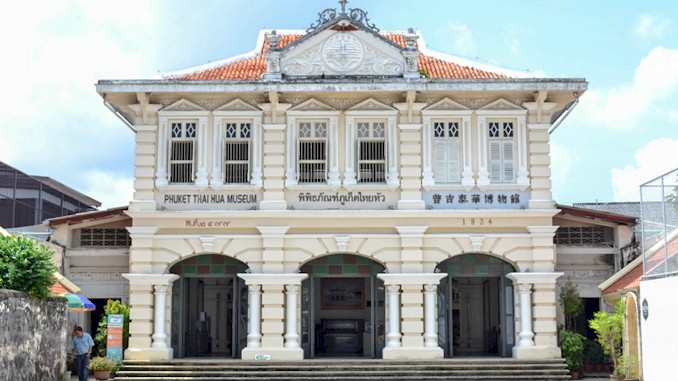
One of the most impressive and well-preserved museums in Old Phuket Town is the Thai Hua Museum. This museum is housed in a former Chinese-language school that was built in 1917 by the local Chinese community. The museum showcases the history and culture of the Chinese immigrants who came to Phuket and contributed to its development and prosperity.
The museum consists of 16 exhibition rooms, each with a different theme and display. Some of the highlights are:
- The Arrival Room: This room tells the story of how the first Chinese settlers arrived in Phuket in the 16th century, fleeing from wars and poverty in China. They came by boat and settled along the coast, working as fishermen, traders, and laborers. They also brought their beliefs, customs, and traditions, which influenced the local culture and society
- The Tin Mining Room: This room explains how tin mining became the main industry in Phuket from the 18th to the 20th century, attracting more Chinese immigrants who worked as miners, smelters, and merchants. Tin mining was a lucrative business that made Phuket one of the richest provinces in Thailand. It also changed the landscape and environment of the island
- The Sino-Portuguese Room: This room displays the unique architectural style of Phuket Town, which is a blend of Chinese and European influences. The Sino-Portuguese shophouses were built by wealthy Chinese families who wanted to show their status and taste. They featured elaborate facades, arched windows, tiled roofs, and spacious courtyards. Many of these buildings are still standing today and have been renovated and restored
- The Shrine Room: This room showcases the religious diversity and harmony of Phuket, where Buddhism, Taoism, Confucianism, Christianity, Islam, and Hinduism coexist peacefully. The room features various statues, altars, and artifacts from different faiths and temples. It also explains the origin and significance of some of the festivals and ceremonies that are celebrated in Phuket, such as the Vegetarian Festival, the Hungry Ghost Festival, and the Ching Ming Festival
- The Classroom Room: This room recreates a typical classroom from the past, where students learned Chinese language, literature, history, and morals. The room displays old textbooks, desks, chairs, blackboards, and other school items. It also shows how education evolved over time in Phuket, from traditional to modern methods
- The Peranakan Room: This room introduces the Peranakan or Baba-Nyonya culture, which is a fusion of Chinese and Malay elements. The Peranakan people are descendants of Chinese immigrants who married local Malay women and adopted some of their language, cuisine, clothing, and art. The room exhibits some of the distinctive features of Peranakan culture, such as the colorful costumes, jewelry, ceramics, furniture, and handicrafts
The Thai Hua Museum is not only a place to learn about the past but also a place to appreciate the present. The museum organizes various activities and events throughout the year, such as workshops, seminars, concerts, exhibitions, and festivals. The museum also has a cafe where you can enjoy some delicious snacks and drinks while admiring the beautiful garden.
The Thai Hua Museum is open daily from 9 am to 5 pm (except on Wednesdays). The admission fee is 200 baht for adults and 100 baht for children (under 12 years old). The museum is located on Krabi Road in Phuket Town (see map below). You can easily reach it by car or public transportation (bus or songthaew).
If you are interested in exploring the Chinese influence on Phuket’s history and culture, you should not miss visiting the Thai Hua Museum. It is one of the best museums in Old Phuket Town that will give you a deeper understanding and appreciation of this amazing place
2. Chinpracha House Museum
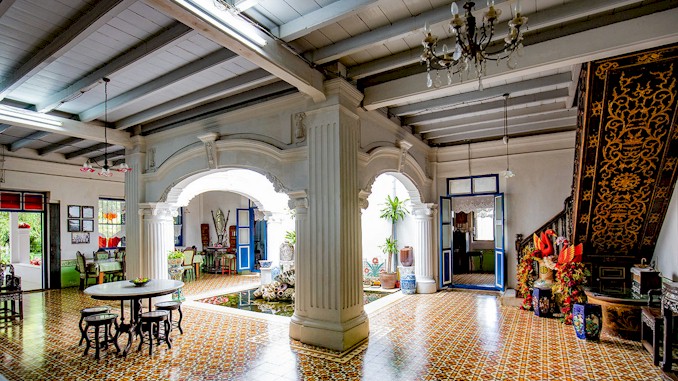
Another museum that you should visit in Old Phuket Town is the Chinpracha House Museum. This museum is also known as Baan Chinpracha or Pithak Chinpracha House. It is a private colonial-style mansion that was built in 1903 by its original owner, Pratipak Chinpracha, a wealthy Chinese tin miner. The mansion is one of the finest examples of Sino-Portuguese architecture in Phuket, with a blend of Chinese and European influences.
The museum is located on Krabi Road, near the Thai Hua Museum. It is open daily from 9 am to 4:30 pm (except on Sundays). The admission fee is 150 baht for adults and 100 baht for children. You can also pay an extra 200 baht if you want to take photos inside the museum. The museum is still occupied by the descendants of Pratipak Chinpracha, who live on the second floor. Only the ground floor is open to the public, where you can see the personal items and furniture of the Chinpracha family.
The ground floor consists of six rooms, each with a different theme and display. Some of the highlights are:
- The Entrance Hall: This hall welcomes you with a grand staircase, a chandelier, and a portrait of Pratipak Chinpracha. You can also see some antique clocks, vases, and statues that decorate the hall
- The Living Room: This room is where the family entertained their guests and held parties. It features a large wooden table, leather sofas, a fireplace, and a piano. You can also see some paintings, photos, and trophies that show the family’s achievements and interests
- The Dining Room: This room is where the family enjoyed their meals and celebrated special occasions. It has a long wooden table, a buffet cabinet, and a display of silverware and porcelain. You can also see some old menus and recipes that reflect the family’s taste and style
- The Bedroom: This room is where Pratipak Chinpracha and his wife slept and relaxed. It has a four-poster bed, a dressing table, a wardrobe, and a fan. You can also see some personal items, such as clothes, jewelry, perfume bottles, and cosmetics
- The Study Room: This room is where Pratipak Chinpracha worked and read. It has a desk, a bookcase, a typewriter, and a telephone. You can also see some documents, letters, newspapers, and books that show his business and intellectual activities
- The Kitchen: This room is where the family cooked and stored their food. It has a stove, a sink, a refrigerator, and a pantry. You can also see some utensils, pots, pans, dishes, and containers that show the family’s culinary preferences and habits
The Chinpracha House Museum is not only a place to admire the beauty and elegance of Sino-Portuguese architecture but also a place to learn about the history and culture of Phuket’s elite class in the past century. It is one of the best museums in Old Phuket Town that will give you an insight into the lifestyle and personality of Pratipak Chinpracha and his family.
3. Baan Ar Jor House Museum
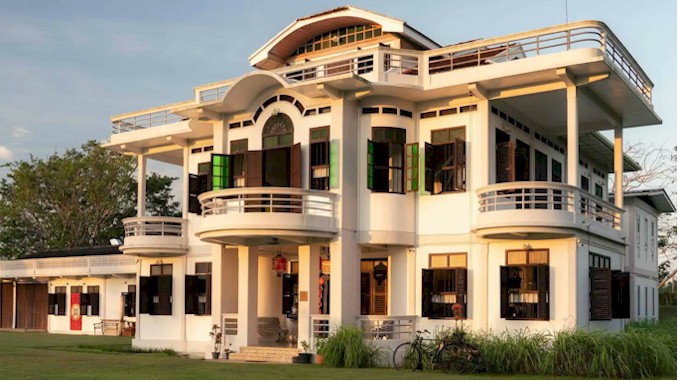
If you want to experience the tin mining era of Phuket, you should visit the Baan Ar Jor House Museum. This museum is also known as Baan Ar Jor Museum Home or Baan Ar Jor Heritage Museum Home. It is a private mansion that was built in 1936 by Tan Jin Nugn, a Chinese tin miner who became a wealthy and influential businessman in Phuket. The mansion is located on Mai Khao Beach, near the airport, and is surrounded by a beautiful garden and a pond
The museum is run by the fourth generation of Tan Jin Nugn’s family, who live on the second floor of the mansion. The ground floor and the third floor are open to the public, where you can see the original furniture, personal items, and collections of the family. The museum also serves as a one-exclusive-room homestay and a restaurant that offers authentic Phuket food. The museum is dedicated to preserving and promoting the history and culture of Phuket’s tin mining industry and its impact on the island’s development and society
The ground floor consists of four rooms, each with a different theme and display. Some of the highlights are:
- The Lobby: This room welcomes you with a stunning mural painting of peonies, which symbolize prosperity and honor in Chinese culture. You can also see some antique furniture, lamps, and statues that decorate the room
- The Dining Room: This room is where the family enjoyed their meals and celebrated special occasions. It features a long wooden table, a buffet cabinet, and a display of silverware and porcelain. You can also see some old menus and recipes that reflect the family’s taste and style
- The Working Corner: This room is where Tan Jin Nugn worked and read. It has a desk, a bookcase, a typewriter, and a telephone. You can also see some documents, letters, newspapers, and books that show his business and intellectual activities
- The Kitchen: This room is where the family cooked and stored their food. It has a stove, a sink, a refrigerator, and a pantry. You can also see some utensils, pots, pans, dishes, and containers that show the family’s culinary preferences and habits
The third floor consists of four rooms, each with a different theme and display. Some of the highlights are:
- The Bridal Room: This room is where Tan Jin Nugn and his wife slept and relaxed. It has a four-poster bed, a dressing table, a wardrobe, and a fan. You can also see some personal items, such as clothes, jewelry, perfume bottles, and cosmetics
- The Children’s Room: This room is where Tan Jin Nugn’s children played and studied. It has a bunk bed, a desk, a chair, and a toy box. You can also see some toys, books, games, and photos that show the children’s hobbies and interests
- The Guest Room: This room is where Tan Jin Nugn’s guests stayed when they visited him. It has a double bed, a sofa, a table, and a lamp. You can also see some paintings, souvenirs, and gifts that show the guests’ identities and relationships with Tan Jin Nugn
- The Homestay Room: This room is where you can stay overnight if you want to experience living in the mansion. It has a double bed, a balcony, a bathroom, and an air conditioner. You can also enjoy the view of the garden and the pond from the balcony. The room rate is 5,000 baht per night (including breakfast)
The Baan Ar Jor House Museum is not only a place to admire the beauty and elegance of Sino-Portuguese architecture but also a place to learn about the history and culture of Phuket’s tin mining era in the 20th century. It is one of the best museums in Old Phuket Town that will give you an insight into the lifestyle and personality of Tan Jin Nugn and his family.
4. Peranakannitat Museum
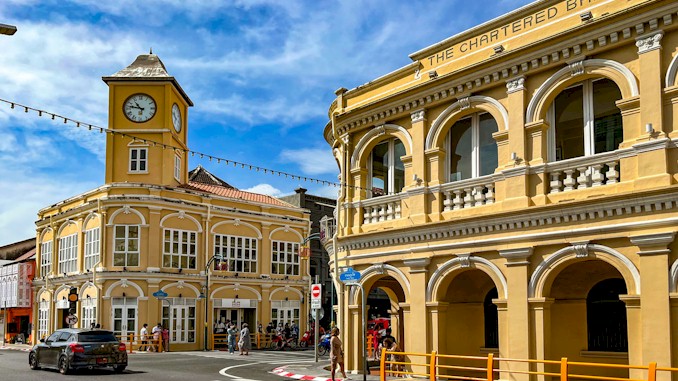
One of the newest and most modern museums in Old Phuket Town is the Peranakannitat Museum. This museum is also known as Baba Museum or Chalermraj Center. It is located in a former bank building that was renovated and opened in 2017. The museum tells the story of Phuket from its early history to the present day, with photo exhibitions and workshops. The museum also aims to preserve and promote the culture and identity of the Peranakan or Baba people, who are descendants of Chinese immigrants who married local Malay women and adopted some of their language, cuisine, clothing, and art.
The museum consists of six exhibition rooms, each with a different theme and display. Some of the highlights are:
- The Arrival Room: This room shows how the first Chinese settlers arrived in Phuket in the 16th century, fleeing from wars and poverty in China. They came by boat and settled along the coast, working as fishermen, traders, and laborers. They also brought their beliefs, customs, and traditions, which influenced the local culture and society.
- The Reborn Room: This room explains how the Chinese immigrants assimilated into the local Malay community and created a hybrid culture known as Peranakan or Baba. The room features some of the distinctive features of Peranakan culture, such as the colorful costumes, jewelry, ceramics, furniture, and handicrafts.
- The Chim Jae Room: This room displays the unique architectural style of Phuket Town, which is a blend of Chinese and European influences. The room features a skylight that allows natural light to enter the building. The room also showcases some of the Sino-Portuguese shophouses that were built by wealthy Chinese families who wanted to show their status and taste.
- The Clothes Room: This room exhibits the traditional clothing of the Peranakan people, which is a fusion of Chinese and Malay elements. The room shows how the Peranakan people dressed for different occasions, such as weddings, festivals, and parties. The room also shows how the Peranakan clothing evolved over time to adapt to modern trends and styles.
- The Food Room: This room introduces the Peranakan cuisine, which is a mix of Chinese, Malay, Indian, and Portuguese flavors. The room shows how the Peranakan people used local ingredients and spices to create dishes that are sweet like Chinese food but spicy like Malay food. The room also shows how the Peranakan food reflects their culture and identity.
- The Steady Room: This room celebrates the Peranakan culture and lifestyle in Phuket today. The room shows how the Peranakan people maintain their traditions and values while embracing modernity and diversity. The room also shows how the Peranakan people contribute to Phuket’s economy, society, and tourism.
The Peranakannitat Museum is not only a place to learn about the past but also a place to appreciate the present. The museum organizes various activities and events throughout the year, such as workshops, seminars, concerts, exhibitions, and festivals. The museum also has a cafe where you can enjoy some delicious snacks and drinks while admiring the beautiful mural paintings on the walls.
The Peranakannitat Museum is open daily from 10 am to 8 pm (except on Sundays). The admission fee is free for everyone. You can also pay an extra 200 baht if you want to take photos inside the museum. The museum is located at the intersection of Phang Nga Road and Phuket Road in Phuket Town (see map below). You can easily reach it by car or public transportation (bus or songthaew).
If you are interested in exploring the history and culture of Phuket from ancient to modern times, you should not miss visiting the Peranakannitat Museum. It is one of the best museums in Old Phuket Town that will give you a deeper understanding and appreciation of this amazing place.
5. Phuket Glass Plates Museum
One of the most unique and interesting museums in Old Phuket Town is the Phuket Glass Plates Museum. This museum is housed in a two-story Sino-Portuguese building that was formerly a bank. The museum showcases the old photos of Phuket Town, vintage camera collection, and over 2,000 glass plates that were used to develop photos in the past. The museum also features a cafe and an eatery where you can enjoy some delicious snacks and drinks while admiring the beautiful mural paintings on the walls.
The museum was founded by Lian-Eaw, a photo and camera shop that was established in 1937 by Mr. Lian Eaw. The shop was the center of everything to do with photography for all ages and occupations in Phuket Town. Only rich people and those in the higher levels of society could afford to have a camera, so everyone else frequented this shop to have their photos taken or developed. The shop also sold cameras, films, accessories, and souvenirs. The shop was closed in 2015, but the family decided to preserve and display their collection of photos, cameras, and glass plates in the museum.
The glass plate development process was the foundation of photography and was used from the late 19th century to the early 20th century. It involved coating a glass plate with a light-sensitive emulsion and exposing it to light in a camera. The plate was then developed in a darkroom using chemicals to produce a negative image. The negative image could then be printed on paper or transferred to another glass plate to create a positive image. The glass plates were fragile and heavy, but they produced high-quality images that could be enlarged or reproduced easily.
The museum consists of six exhibition rooms, each with a different theme and display. Some of the highlights are:
- The Lobby: This room welcomes you with a stunning mural painting of peonies, which symbolize prosperity and honor in Chinese culture. You can also see some antique furniture, lamps, and statues that decorate the room
- The History Room: This room tells the story of Lian-Eaw, the photo and camera shop that was founded by Mr. Lian Eaw in 1937. You can see some photos of Mr. Lian Eaw and his family, as well as some documents, letters, newspapers, and books that show his business and intellectual activities
- The Camera Room: This room displays a variety of cameras from different eras and countries, such as Kodak, Leica, Nikon, Canon, Polaroid, and more. You can see how cameras evolved over time from simple to complex devices. You can also see some accessories, such as lenses, filters, tripods, and flashlights
- The Glass Plate Room: This room exhibits over 2,000 glass plates that were used to develop photos in the past. You can see how glass plates were made and processed in the darkroom using chemicals and equipment. You can also see some examples of negative and positive images on glass plates that show the scenes of Phuket Town from the late 19th century to the early 20th century
- The Photo Room: This room showcases some of the old photos of Phuket Town that were taken or developed by Lian-Eaw. You can see how Phuket Town looked like in the past, with its Sino-Portuguese buildings, streets, temples, markets, festivals, and people. You can also see some portraits of famous or influential people who visited or lived in Phuket Town, such as King Rama IX, Prince Philip, Queen Elizabeth II, Jackie Kennedy, John Wayne, and more
- The Workshop Room: This room offers you a chance to experience the glass plate development process yourself. You can learn how to coat a glass plate with emulsion, expose it to light in a camera, develop it in a darkroom using chemicals, and print it on paper or transfer it to another glass plate. You can also learn how to restore or repair damaged glass plates using special techniques and tools
The Phuket Glass Plates Museum is not only a place to admire the beauty and quality of glass plate photography but also a place to learn about the history and culture of Phuket Town in the past century. It is one of the best museums in Old Phuket Town that will give you a glimpse into the old Phuket through glass plates.
6. Mining Museum
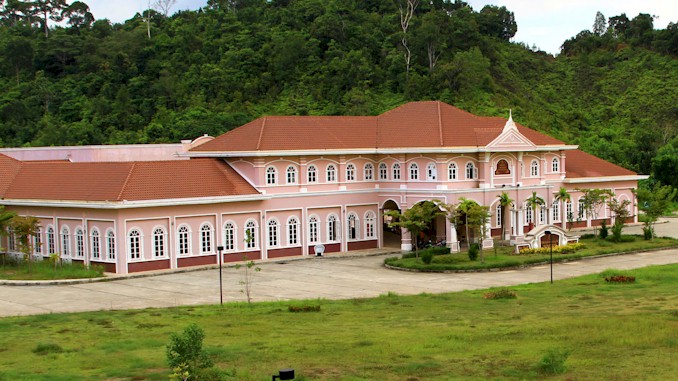
One of the most educational and historical museums in Old Phuket Town is the Mining Museum. This museum is located in Kathu, on the road between Loch Palm Golf Club and British International School. The museum features displays ranging from tin mine models to a recreated scene in an opium den. The museum aims to preserve and promote the history and culture of Phuket’s tin mining industry and its impact on the island’s development and society.
The museum was established in 2009 by Kathu Municipality, with the support of local people and organizations. The museum is situated on an about 400 rai area that was once a large mineral mine with rich natural resources. The area was abandoned after tin was depleted, until it was developed into a mining museum. The museum is surrounded by naturally rich hills and has a beautiful landscape.
The museum consists of six exhibition rooms, each with a different theme and display. Some of the highlights are:
- The Beginning Room: This room shows how the earth was formed and how minerals and animals evolved over time. It also shows how tin was discovered and used by ancient civilizations, such as Egypt, China, Greece, and Rome.
- The Tin Mining Room: This room explains how tin mining became the main industry in Phuket from the 18th to the 20th century, attracting more Chinese immigrants who worked as miners, smelters, and merchants. It also shows how tin mining was a lucrative business that made Phuket one of the richest provinces in Thailand. It also shows how tin mining changed the landscape and environment of the island.
- The Sino-Portuguese Room: This room displays the unique architectural style of Phuket Town, which is a blend of Chinese and European influences. It also shows how wealthy Chinese families built Sino-Portuguese shophouses and mansions to show their status and taste. It also shows how Phuket Town became a cosmopolitan and multicultural city with diverse religions, languages, cuisines, and arts.
- The Opium Den Room: This room recreates a scene in an opium den, where people smoked opium for pleasure or pain relief. It also shows how opium was a social problem that affected many people in Phuket, especially miners who suffered from diseases, injuries, or depression. It also shows how opium was banned by the government and replaced by other drugs, such as heroin or methamphetamine.
- The Local Life Room: This room showcases the local life and culture of Phuket during the tin mining era. It shows how people dressed, ate, worked, played, and celebrated in different occasions, such as weddings, festivals, and parties. It also shows how people preserved their traditions and values while adapting to modernity and diversity.
- The Future Room: This room celebrates the future of Phuket after the tin mining era. It shows how Phuket transformed from a mining island to a tourism island, with its beautiful beaches, natural attractions, cultural heritage, and hospitality. It also shows how Phuket faces new challenges and opportunities in the 21st century, such as environmental issues, social problems, economic development, and global integration.
The Mining Museum is not only a place to learn about the past but also a place to appreciate the present. The museum organizes various activities and events throughout the year, such as workshops, seminars, concerts, exhibitions, and festivals. The museum also has a souvenir shop where you can buy some products made from tin or related to tin mining.
The Mining Museum is open daily from 9 am to 4 pm (except on public holidays). The admission fee is 100 baht for adults and 50 baht for children (under 12 years old). You can also pay an extra 200 baht if you want to take photos inside the museum. The museum is located on Kathu-Ko Kaeo Road in Kathu. You can easily reach it by car or public transportation (bus or songthaew).
If you are interested in exploring the tin mining industry and its impact on Phuket’s history and culture, you should not miss visiting the Mining Museum. It is one of the best museums in Old Phuket Town that will give you a deeper understanding and appreciation of this amazing place.
7. Phuket Trickeye Museum

One of the most fun and interactive museums in Old Phuket Town is the Phuket Trickeye Museum. This museum is located in a former movie theater that was renovated and opened in 2014. The museum features over 100 paintings and sculptures that create 3D illusions and optical effects. The museum invites you to become part of the art and take photos with various scenes and characters. The museum also has a cafe where you can enjoy some snacks and drinks while admiring the artworks.
The museum consists of six zones, each with a different theme and display. Some of the highlights are:
- Aquarium Zone: This zone takes you to the underwater world, where you can see and interact with various marine creatures, such as sharks, dolphins, turtles, octopuses, and more. You can also see some famous landmarks, such as the Eiffel Tower, the Statue of Liberty, and the Leaning Tower of Pisa, submerged in water.
- Safari Zone: This zone takes you to the wild jungle, where you can see and interact with various animals, such as lions, tigers, elephants, giraffes, zebras, and more. You can also see some humorous scenes, such as a monkey riding a bicycle, a zebra crossing a road, and a lion playing golf.
- Classic Art Zone: This zone takes you to the world of classic art, where you can see and interact with some famous paintings and sculptures, such as Mona Lisa, The Last Supper, The Scream, The Thinker, and more. You can also see some creative interpretations of these artworks, such as Mona Lisa with a mustache, The Last Supper with pizza, The Scream with headphones, and The Thinker with a toilet.
- Fantasy Zone: This zone takes you to the world of fantasy and imagination, where you can see and interact with some mythical creatures and characters, such as dragons, unicorns, fairies, mermaids, superheroes, and more. You can also see some magical scenes, such as flying on a broomstick, walking on a rainbow, riding on a roller coaster, and escaping from a giant spider.
- Lanna Zone: This zone takes you to the world of Lanna culture, which is the ancient culture of northern Thailand. You can see and interact with some traditional elements and symbols of Lanna culture, such as elephants, umbrellas, lanterns, temples, and more. You can also see some cultural performances and activities, such as dancing, playing music, making handicrafts, and celebrating festivals.
- Phuket Zone: This zone takes you to the world of Phuket culture and lifestyle. You can see and interact with some local elements and attractions of Phuket island, such as beaches, boats, seafood markets, Sino-Portuguese buildings etc. You can also see some local people and their occupations or hobbies such as fishermen or surfers etc.
The Phuket Trickeye Museum is not only a place to admire the beauty and creativity of 3D paintings and optical illusions but also a place to have fun and express yourself. The museum encourages you to pose with the artworks in any way you like and take photos or videos with your own camera or smartphone. The museum also provides free Wi-Fi for you to share your photos or videos on social media platforms.
The Phuket Trickeye Museum is open daily from 10 am to 7 pm (last admission at 6 pm). The admission fee is 500 baht for adults and 300 baht for children (under 130 cm). It’s quite expensive and if you want to get a discount, you can go to my article about it by clicking this link. You can also get discounts if you book online or show your student ID card or work permit. The museum is located on Montri Road in Phuket Town. You can easily reach it by car or public transportation (bus or songthaew).
If you are looking for a fun and interactive experience in Old Phuket Town that will make you laugh and smile then you should not miss visiting the Phuket Trickeye Museum. It is one of the best museums in Old Phuket Town that will give you a memorable time with your friends or family.
8. Phuket Baba Museum
One of the most colorful and cultural museums in Old Phuket Town is the Phuket Baba Museum. This museum is located in a former Chinese school that was built in 1911 by the local Chinese community. The museum celebrates the Peranakan or Baba-Nyonya culture, which is a fusion of Chinese and Malay elements. The Peranakan people are descendants of Chinese immigrants who married local Malay women and adopted some of their language, cuisine, clothing, and art.
The museum consists of four exhibition rooms, each with a different theme and display. Some of the highlights are:
- The History Room: This room tells the story of how the Peranakan culture emerged and evolved in Phuket and other parts of Southeast Asia. It also shows how the Peranakan people contributed to Phuket’s economy, society, and tourism. You can see some photos, documents, maps, and timelines that show the history and diversity of the Peranakan people.
- The Costume Room: This room exhibits the traditional clothing of the Peranakan people, which is a mix of Chinese and Malay styles. You can see some examples of the distinctive features of Peranakan clothing, such as the kebaya (a blouse), the sarong (a skirt), the beaded slippers, and the jewelry. You can also see some modern interpretations of Peranakan clothing, such as dresses, shirts, pants, and shoes.
- The Art Room: This room showcases the artistic skills and talents of the Peranakan people, who excelled in various forms of art, such as painting, embroidery, carving, weaving, and pottery. You can see some examples of the exquisite and intricate artworks that the Peranakan people created or collected, such as paintings, embroideries, carvings, weavings, and ceramics. You can also see some demonstrations and workshops where you can learn how to make or appreciate some of these artworks.
- The Lifestyle Room: This room recreates a typical Peranakan house, where you can see how the Peranakan people lived and celebrated in different occasions, such as weddings, festivals, and parties. You can see some furniture, utensils, decorations, and souvenirs that show the lifestyle and personality of the Peranakan people. You can also see some performances and activities that show the culture and identity of the Peranakan people.
The Phuket Baba Museum is not only a place to admire the beauty and creativity of Peranakan culture but also a place to celebrate and participate in it. The museum organizes various activities and events throughout the year, such as workshops, seminars, concerts, exhibitions, and festivals. The museum also has a souvenir shop where you can buy some products made by or related to Peranakan culture.
The Phuket Baba Museum is open daily from 9 am to 5 pm (except on Mondays). The admission fee is 200 baht for adults and 100 baht for children (under 12 years old). You can also pay an extra 200 baht if you want to take photos inside the museum. The museum is located on Thalang Road in Phuket Town (see map below). You can easily reach it by car or public transportation (bus or songthaew).
If you are interested in exploring the Peranakan culture and lifestyle in Phuket Town then you should not miss visiting the Phuket Baba Museum. It is one of the best museums in Old Phuket Town that will give you a colorful and cultural experience with your friends or family.
9. Phuket Philatelic Museum
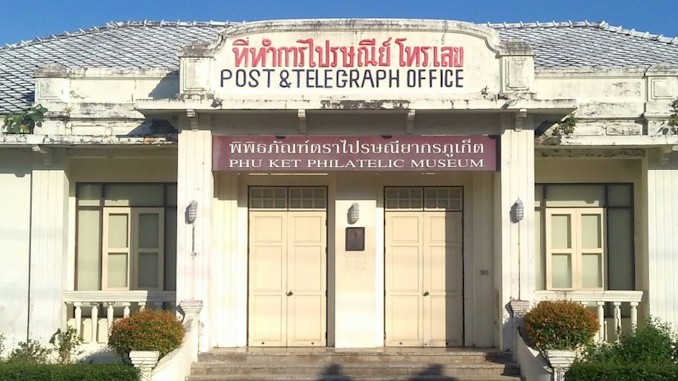
One of the most historic and nostalgic museums in Old Phuket Town is the Phuket Philatelic Museum. This museum is housed in a former post and telegraph office that was built in 1930 by the Fine Arts Department. The museum showcases the history and development of postal services and communications in Phuket and Thailand, as well as a collection of stamps from Thailand and other countries. The museum also features a souvenir shop where you can buy some products related to stamps and postcards.
The museum consists of four exhibition rooms, each with a different theme and display. Some of the highlights are:
- The Post Office Room: This room recreates a typical post office from the past, where you can see how postal workers sorted, stamped, and delivered mail. You can also see some old postal equipment, such as scales, postmarks, envelopes, and boxes. You can also try to send a postcard to yourself or your friends from the museum.
- The Telegraph Room: This room explains how telegraphy was introduced and used in Phuket and Thailand, as well as its impact on society and politics. You can also see some old telegraph equipment, such as telephones, typewriters, cables, and machines. You can also try to send a telegram message to yourself or your friends from the museum.
- The Stamp Room: This room displays a variety of stamps from Thailand and other countries, dating from the 19th century to the present day. You can see how stamps evolved over time in terms of design, theme, value, and quality. You can also see some rare and valuable stamps, such as the first stamp of Thailand (the Siamese Red), the first stamp of Phuket (the Phuket Local), and the first stamp of King Rama IX (the Coronation Issue).
- The Gallery Room: This room showcases some special exhibitions and collections of stamps that are related to specific topics or events, such as art, culture, sports, wildlife, history, and more. You can also see some stamp artworks that are created by artists or collectors using stamps as their medium. You can also participate in some activities and workshops that are organized by the museum or other organizations.
The Phuket Philatelic Museum is not only a place to admire the beauty and diversity of stamps but also a place to learn about the history and culture of Phuket and Thailand through postal services and communications. It is one of the best museums in Old Phuket Town that will give you a nostalgic and educational experience with your friends or family.
10. Thavorn Museum
One of the most bizarre and eccentric museums in Old Phuket Town is the Thavorn Museum. This museum is housed in a former hotel that was built in 1920 by Thavorn Wongwaiwit, a pioneer of Phuket’s tourism industry. The museum showcases the personal collection of Thavorn Wongwaiwit, who amassed a range of oddities, such as old toys, weapons, coins, and animal parts. The museum also features a cafe where you can enjoy some snacks and drinks while admiring the artworks.
The museum consists of four exhibition rooms, each with a different theme and display. Some of the highlights are:
- The Toy Room: This room displays a variety of toys from different eras and countries, such as dolls, cars, trains, robots, and more. You can see how toys evolved over time in terms of design, function, and quality. You can also see some rare and valuable toys, such as a Mickey Mouse doll from 1930, a Batman car from 1966, and a Star Wars figurine from 1977.
- The Weapon Room: This room exhibits a collection of weapons from different eras and countries, such as swords, daggers, guns, rifles, and more. You can see how weapons changed over time in terms of shape, size, and power. You can also see some unusual and exotic weapons, such as a Chinese crossbow from 1800, a Japanese katana from 1900, and a German Luger pistol from 1940.
- The Coin Room: This room showcases a collection of coins from different eras and countries, such as Thailand, China, India, Europe, and more. You can see how coins reflected the history and culture of each country. You can also see some rare and valuable coins, such as a Thai bullet coin from 1782, a Chinese dragon coin from 1911, and an Indian gold coin from 1947.
- The Animal Room: This room displays a collection of animal parts from different eras and countries, such as horns, tusks, skins, bones, and more. You can see how animals were used for various purposes, such as decoration, medicine, or food. You can also see some strange and creepy animal parts, such as a crocodile head from 1950, a tiger skin from 1960, and a human skull from 1970.
The Thavorn Museum is not only a place to admire the quirky and curious collection of oddities but also a place to learn about the history and culture of Phuket and the world through Thavorn Wongwaiwit’s eyes. It is one of the best museums in Old Phuket Town that will give you a surprising and amusing experience with your friends or family.



